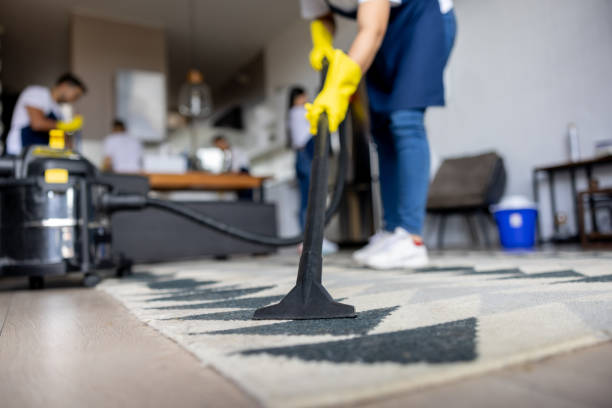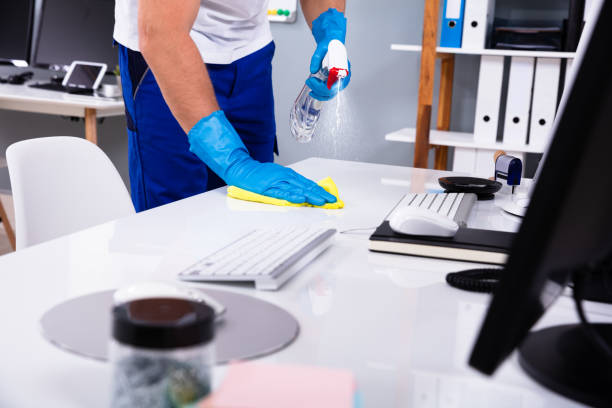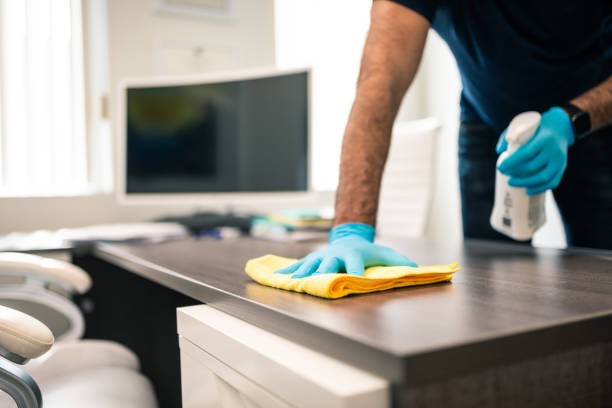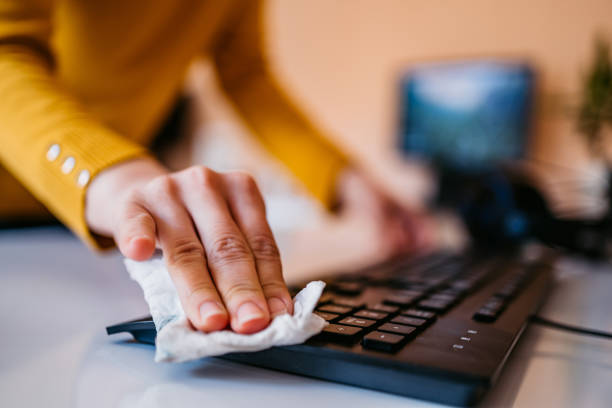How to Prepare Your Office for a Professional Cleaning Appointment
- Vanshika Thareja

- Nov 3
- 10 min read

In order to have a clean, healthy, and productive office, it is necessary to prepare your office in advance for a professional cleaning appointment. Most companies fail to take the necessary precautionary measures, and as such, they end up neglecting clutter, miscommunication, and even loss or damage of items. The following is a step-by-step guide to ensuring your office is really cleaner-ready and that you get the most out of your investment in professional services.
Communicate, Declutter, and Secure: The Fundamentals of Office Cleaning Preparation
The first step to effective office cleaning is clear communication and a well-organized office. Inform the cleaning service agency of your needs and expectations before your cleaning team comes. Talk about problem areas, hot spots where there is a lot of traffic, sensitive electronics, and areas that require special attention (e.g., pantries or meeting rooms). Give a cleaning checklist or request one that is specific to your particular needs so that nothing is missed.
Clutter may be a major impediment to deep cleaning. Instruct your employees to remove personal items, desktop clutter, paperwork, and other valuable items from workstations. This could involve the storage of valuable documents, confidential data, electronics, and anything delicate or of special value. Personal items and decorations must be put away, particularly those that may be broken or lost.
In order to maintain everything going:
1. Make a pre-cleaning to-do list for the staff and hand it out at least one day before:
Create an elaborate checklist that will detail everything that each of the staff members should do before the cleaning crew shows up. Some of the tasks that should be listed here are clearing personal items off desks, sorting paperwork, disconnecting or protecting electronics, and clearing away anything that might hinder a thorough cleaning. When ready, send out this checklist to all staff at least 24 hours beforehand, preferably by email, messaging app, or noticeboard. Advanced delivery allows all people to have sufficient time to prepare, minimizes last-minute rush, and makes the working environment evenly prepared to receive the cleaning service.
2. Mark sensitive equipment (printers, computers, specialty hardware) that should not be moved or touched without supervision:
List all office equipment and specialized equipment that is especially delicate, complicated or essential to everyday operations, e.g., desktop computers, multifunction printers, servers, or scientific equipment. It is important to clearly identify these items using tags or signs so that they cannot be moved, unplugged, or cleaned without the supervision of a specific staff member. This proactive labeling will assist cleaning staff to identify easily which items should not be touched to avoid damaging the item, loss of data or service interruption.
3. Set up access procedures.
Provide keys to locked rooms or cabinets, or designate a staff point person in case cleaners require access to locked rooms or cabinets:
In order to facilitate a complete cleaning, consult with your provider to identify areas that should be off-limits and areas that need special access, like storage rooms, personal offices, or supply cabinets. In the case of such areas that cannot be unlocked during normal working hours, make arrangements to provide keys or access cards to the cleaning staff, or have one of the trusted employees to unlock and oversee these areas during the cleaning process. Effective communication and clear access protocols reduce the risk of confusion and unauthorized access and streamline the process to be more secure and efficient on both sides of the cleaning staff and your team.
4. Anticipate minimum disturbance.
Speak to the cleaning service about when the best times are to do deep cleans, such as after hours, weekends or off-peak times, and relay this information to the employees:
Discuss with your cleaning service provider when the cleaning should take place so that it will cause minimal disruption to your business, e.g., evenings, weekends, or any time most of your staff are not present. After coming up with an agreed schedule, inform all employees in advance of such plans via internal memos, digital calendars, or team meetings. This will eliminate surprises, stop work interruptions, and enable employees to prepare their spaces accordingly. It also assures employees that the productivity and workflow have been given priority, and the office environment is healthy and clean.
Finally, ensure that any safety issues are handled early enough-like chemical allergies or specific cleaning products requests, to enable the cleaning team to cater to them. Pre-planning not only makes the process faster but also more complete and effective, safeguarding your property and employees.
How to Prepare for Office Carpet Cleaning

Carpet is one of the primary features in an office setting that suffers the greatest punishment from foot traffic, coffee spills, ink stains, and even pollen or allergens.
Before hiring professional office carpet cleaning singapore services, there are a few additional, special measures you will need to take to prepare your workplace to get the best out of the cleaning process and keep your flooring in good shape.
Check your cleaning schedule first: Office carpet cleaning Singapore services advise that deep cleaning should be done after every six to twelve months, and more frequently in locations with high traffic. Before every appointment:
Clear carpeted spaces of everything: This involves chairs, movable partitions, trash receptacles, office furniture, and anything that is on the carpet. Professional cleaners do not tend to move heavy furniture, and cleaning these areas will allow access to all the fibres.
Vacuum beforehand: Even though cleaners will do a good vacuum, beginning with floors that have no debris on them-no paperclips, staples, or loose dirt-allows their equipment to concentrate on the more thorough cleaning.
Check stains spot-wise: Indicate areas of chronic stains or problem areas to your cleaning staff- they can then use special pre-treatments and get the most out of them.
Shield nearby surfaces: In case your office is designed with specialized flooring besides the carpet (i.e., tile or wood), talk to your provider about how these transitions will be covered and safeguarded.
Make water, electricity, and drains available: The carpet cleaning machines might need power and running water; tell your cleaning service where they are.
Convey dry time: Certain cleaning procedures may necessitate drying of carpets, which may take several hours. Ensure that you limit foot traffic or use wet floor signs until the carpets are completely dry.
It is essential to hire an office carpet cleaning Singapore company with NEA-certified qualifications and environmentally friendly cleaning chemicals. Eco steam cleaning and modern stain-removal methods enhance hygiene, minimize chemical residue and smell, and maintain the indoor environment safe. Always check whether there is an after-hours service (so that it does not disrupt business) and find out whether they do quick-dry solutions so that the office is ready to be used as soon as possible.
Arranging Workstations, Electronics, and Sensitive Equipment

The real challenge of a clean office is in the details, particularly in the case of electronics and workstations. Electronics are prone to dust, fingerprints, and even food debris, which undermine their performance and hygiene unless they are cleaned accordingly.
These areas can be prepared in the following way:
Turn off and unplug unnecessary electronics. This guards against accidents to both the hardware and cleaning personnel when dusting or cleaning the surface.
Mark Do Not Touch. Find out delicate IT devices, servers, or personal docking stations that must not be wiped, relocated, or unplugged.
Cord bundle and elevate. To keep cords out of the way, use cable management solutions to tie them together and raise them off the ground so that vacuuming and mopping are simple and there is no danger of accidentally pulling the cord out.
Protect screens. Cover sensitive monitor displays with place screen covers, or have cleaners avoid harsh chemicals on them- microfiber and ammonia-free products are preferred.
Store peripherals. Request that employees lock away removable drives, headphones, mice, and other personal equipment.
Protect sensitive and trade secrets. Put all sensitive documents and papers in locked drawers, locked cabinets, or in areas marked as non-cleanable.
Ask your cleaning vendor to clean all electronics using non-abrasive, anti-static cleaning chemicals and highlight special needs on their checklist. By urging employees to log off and clean their workstations, not only can accidents be avoided, but it will also allow the cleaning staff to provide a more thorough, effective service.
Management of Communal Spaces, Meeting Spaces, and Kitchens
Besides workstations, common spaces are to be prepared specially because of excessive use and high-touch surfaces.
Begin with Communal Kitchens and Pantries:
Throw away or Keep All Food Supplies. Before the appointment, take out the perishables and empty the refrigerator. Make sure that the kitchen is clear of food clutter prior to the arrival of the cleaning crew. Individual and communal food storage should be inspected by employees; this includes refrigerators, cabinets, or drawers, and any food that is expired or unwanted should be discarded. Perishable items (such as fruit, dairy, and leftovers) should be taken out of the fridge, particularly when cleaning requires defrosting or thoroughly cleaning the appliance, as cleaners may require an entirely clear area in order to thoroughly clean shelves and drawers. This also avoids unintentional wastage or discarding of individual foodstuffs.
Clean Wipe Down Surfaces and Empty Dish Racks:
Before the arrival of the cleaning staff, all dishes, mugs, or utensils must be cleaned and dried and placed away. Clean surfaces and clear countertops, and dish racks make sure that cleaners are able to sanitize all surfaces thoroughly and efficiently. Getting rid of clutter will also eliminate the chance of items being misplaced, knocked over or broken in the process of cleaning. Ask employees to carry their personal dishware home or store it safely.
Use of Secure Staff Mugs, Utensils, or Reusable Items to Avoid Accidental Loss:
Personalized mugs, water bottles, or reusable cutlery are common in many offices. Request team members to keep these on their desks or in well-labeled bins/cabinets. This will avoid confusion or loss, particularly since cleaning crews might have to relocate items to clean shelves, sinks, and countertops. Being aware that personal items are stored brings comfort to the employees and eases the cleaning process.
In the case of Meeting Rooms and Common Spaces:

Remove Presentation Materials, Whiteboard Markers, and Electronic Accessories:
Clear the temporary objects like presentation handouts, notepads, whiteboard markers, erasers, charging cables, and other accessories that might be lying on the tables or shelves. This avoids the loss or destruction of valuable materials and allows all surfaces, such as tables, credenzas, and AV units, to be cleaned, wiped down, dusted, and sanitized.
Under Tables Push Chairs to Access Floor Spaces Easily:
Have employees (or designate a point person) to push all chairs and stools under tables or stack them, where possible. This minor action greatly accelerates the work of the cleaning crew as it gives them clear access to the floor, allowing vacuuming and mopping to be more efficient and complete.
Where possible, relocate any valuable artwork or electronics (projectors, remote controls) to a secure location:
Find and remove all office items of high value or fragile items like artworks, decor, projectors, or remote controls to a safe place before cleaning begins. This lowers the risk of unintentional breakage when dusting or cleaning the surface. In cases of larger objects that are immovable, you should wrap them in protective cloths or ask the cleaning staff to be extra careful around them.
Bathrooms and Washrooms Must Be Prepared as well:
Make Sure that the Cleaning Crew Has Adequate Handwashing Supplies, Soap, and Paper Towels:
Purchase soap, disposable paper towels, toilet paper, and hand sanitizers in every bathroom. Such supplies are necessary not only to the employees but also to the cleaning team, who have to stay hygienic before, during, and after work. Availability of supplies makes it possible to conduct a comprehensive sanitization process and speaks of the organizational commitment to hygiene.
Inform whether any of the restrooms need thorough cleaning or servicing of equipment (e.g., hand dryers or air fresheners):
Inform the cleaning service about any special requirements in the restrooms, e.g., intensive cleaning of high-traffic bathrooms, decalcification of fixtures, or any special services (refilling air fresheners, cleaning hand dryers, etc.). In case some equipment needs maintenance or there have been some recent problems (such as leaks or odor issues), it is best to inform about them in advance so that the crew can arrive with the appropriate tools and cleaning chemicals.
To prevent inconvenience during busy times, notify the Staff in advance:
Communication helps avoid interruption of the working day. Send an email, chat, or a noticeboard to all staff informing them of the bathroom cleaning schedule and common area cleaning. Make it clear whether certain facilities will be temporarily out of order so that employees can plan their schedules accordingly (e.g., using other bathrooms when the ones being cleaned are unavailable). This factor makes the working process stressful and frustrating.
By adhering to and extending each of these preparatory steps in detail, your office will be able to guarantee the most effective and thorough cleaning. Not only does this make the workplace safer and friendlier, but it also extends the life of common facilities and strengthens positive working behaviors.
These procedures simplify the process of cleaning in high-traffic areas of your office so that nothing is overlooked and nothing is lost or broken.
Day-Of Checklist: What to Do Just Before the Cleaning Crew Comes

Last-minute preparations on the day of the cleaning appointment will make things work out well:
Notify every employee about the appointment: Write a courtesy email the previous night with a list of actions to be taken (such as clearing desks and taking away valuable items).
Be sure to check again that doors and windows are open and that the cleaning crew has the proper access codes, cards, or keys.
Make sure that utilities are on: Ensure that the cleaning team has power, water, and lighting.
Mark off restricted areas: Put up signage or temporary barriers to rooms or zones that are no-go for cleaning.
Adjust the thermostat or ventilator: When deep cleaning or carpet cleaning is planned, good airflow may accelerate drying and maintain good air quality.
Recheck special requests: Ensure that instructions regarding stain treatments, environmentally friendly products, or allergies/sensitivities are well-informed.
When your crew arrives, have a point person (preferably a supervisor or an admin) meet them, go over the cleaning checklist, answer questions, and walk the space. This handoff makes both parties consistent and reduces confusion.
Cleaning an Office After Business
With the help of joint daily practices, the effects of a professional deep clean can be maintained longer:
Establish a daily cleaning habit among all the employees-cleaning of surfaces, filing of papers, and maintaining personal storage space.
Designate duties to shared spaces, or have light in between cleanings of bathrooms and break rooms.
Promote the use of clean as you go, particularly in pantries and communal workstations.
Purchase easy-to-use cleaning products: Have disinfectant wipes, hand sanitizers, and cleaning sprays on hand to use between professional cleanings.
Revise your cleaning checklist on a regular basis, changing it to reflect seasonal changes or events that change usage patterns.
Taking small steps to maintain the workspace clean on a regular basis will result in faster, easier, and more affordable professional cleaning sessions, and the office will be healthier and more productive.
Conclusion: Professional Cleaning
Getting your office ready to have a professional cleaning appointment is not only about creating space where the crew will work, but also about streamlining the process to the benefit of everyone involved. Clearing away clutter and packing up sensitive materials, preparing to have the deep carpet cleaning and to organize workstations, these preparatory measures will guarantee a comprehensive outcome, reduce the impact on business, and protect valuable assets. When you take advantage of specialized services like office carpet cleaning Singapore teams can offer, preparation is particularly important because it can make your workplace shine, both literally and figuratively, and help to boost morale and remind yourself that you are committed to a safe and pleasant business environment.

Comments